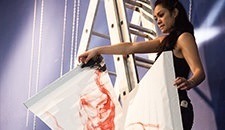Part connoisseur, part salesman, part financial expert. The art broker is a complex figure that operates through different spheres of the art world. His job defies a clear-cut definition inasmuch as his expertise encompasses a wide range of tasks and responsibilities. Broadly speaking, an art broker is a professional of the art market who helps collectors and art investors make the right choices when buying art. Their clients include art dealers, such as gallery owners and private collectors, and even companies seeking to diversify their portfolio or create a sophisticated corporate image by investing in an art collection.
The art broker’s main task is to advise and assist art buyers in all the aspects of the sale and purchase of art objects: they negotiate prices and bidding on their clients’ behalf, inform them on the investment potential of artworks on the market, conduct preliminary surveys to verify the works’ authenticity and check their conditions before their acquisition, discover art objects that might be interesting investments or valuable additions to an owner’s collection, elaborate market strategies to place artworks already in their clients’ possession, help eager art collectors ride the hottest trends of the art market.
In addition to providing safe and experienced guidance through the snares of art trading, art brokers are art experts with highly specialized knowledge of an artistic period, style, or artist. They can offer ultra-qualified advice on the acquisition of Northern Italian Renaissance paintings or American modernist photography, work with contemporary art galleries or collectors of 18th century Chinese ceramics. Their knowledge of the history of art enables them to assess the artistic quality and value of a work, verify its authenticity and review any supporting documentation attesting to the work’s history. Whatever their specialty, art brokers apply the know-how of a financier to the expertise of a connoisseur: their diverse skills range from an in-depth understanding of specific periods and themes of the history of art to the scientific and technical evaluation of data and statistics of an ever-expanding market.
An Art Market Insider
For an art broker, the tricky mechanisms of the art market have no secrets. While art historians, art critics, curators and other art worlds actors traditionally lack the skills to operate strategically within art investments, art brokers have the specific financial expertise to deal with art as a market commodity and physical asset. Assessing investment potential in art is in fact very different from dealing with other asset classes. [4] To understand, monitor, and - to some extent- manipulate the value of an artwork, the art broker must be aware of trends and dynamics that are peculiar to the art market. For instance, the value of an artwork is built on a series of overlapping and intricate factors that often escape the understanding of traditional investors: these include the artist’s recognizability and desirability, the work’s quality, style, and conditions, and its provenance- meaning its history of ownership and record of inclusion in collections and exhibitions. [5] Art brokers also have privileged access to those centers of control and power, such as auction houses and art fairs, that greatly influence the trends of the market and the value of an artist’s work or category of objects.
Art Dealers and Art Brokers: How Do They Differ?
Art brokers not only show their clients new directions for their art investments, they can also be in charge of managing and curating their existing collections. Note, however, that art brokers do not usually have collections of their own. This is where the job and responsibilities of an art broker generally differ from those of his doppelganger in the gentle (and ruthless) art of transforming art into money: the art dealer. The art dealer is generally a gallery owner. Art and money make the common thread that links the art broker with the dealer: while both figures operate in the art market and deal with the sale and purchase of art objects, the latter also personally engages with the promotion and curation of his own collection. This involves not only surveying the market for potentially interesting acquisitions, studying its tendencies, and making selling and purchase decisions accordingly- all tasks and responsibilities that art dealers share with brokers; as gallery owners, art dealers personally engage with the discovery and promotion of talented artists, arrange sales and loans for their works, and are committed to giving a distinct identity to their collection through highly thought-out acquisition choices.
Art brokers can nonetheless superintend and offer their advice on all these aspects- except that they do not work to build relationships with artists directly nor they are involved in the advancement of their own art collections. An art dealer’s path can often meet an art broker’s when the former needs specialized assistance to negotiate the acquisition of a work for his gallery or wants to know if his object of interest will stand the test of time. In addition, art dealers avail themselves of brokers’ services to manage the administrative and financial aspects of their collections.
Maximizing Investments and Creating Networks
Developing a good art collection is an expensive and time-consuming process that requires constant and close scrutiny of a global, ever-expanding market scenario. Since the venues of the art market are scattered globally, with new online platforms of art investments launching every day, art brokers often personally survey auctions, art fairs, and exhibitions worldwide in search of interesting deals and pieces for their clients. Global sourcing is only one of the services that art advisory companies- for which art brokers often work- offer to their clients. Fine Art Brokers and Philip Hoffman’s The Fine Art Group are leader art advisory companies employing brokers who oversee the different aspects of their clients’ art investments. For instance, Fine Art Brokers’ experts specialize in 19th century, Impressionist, modern and contemporary art: they work with a global network of contacts, such as private collectors, dealers, and auction houses, providing tailored financial solutions and confidential advice on how to maximize investments when buying or selling specific pieces.
This is a time when private investors are entering the art market in increasing numbers- some driven by the desire to diversify their portfolio, others by an authentic eagerness for owning and collecting art. With their hybrid nature, art brokers can be art buyers’ best friends: not only they customize their advice to cater to the clients’ tastes and artistic preferences, they also strive to protect the buyer’s financial interests, facilitate their investment experience, and enhance the reputation of their collection.


 Download application form
Download application form 


